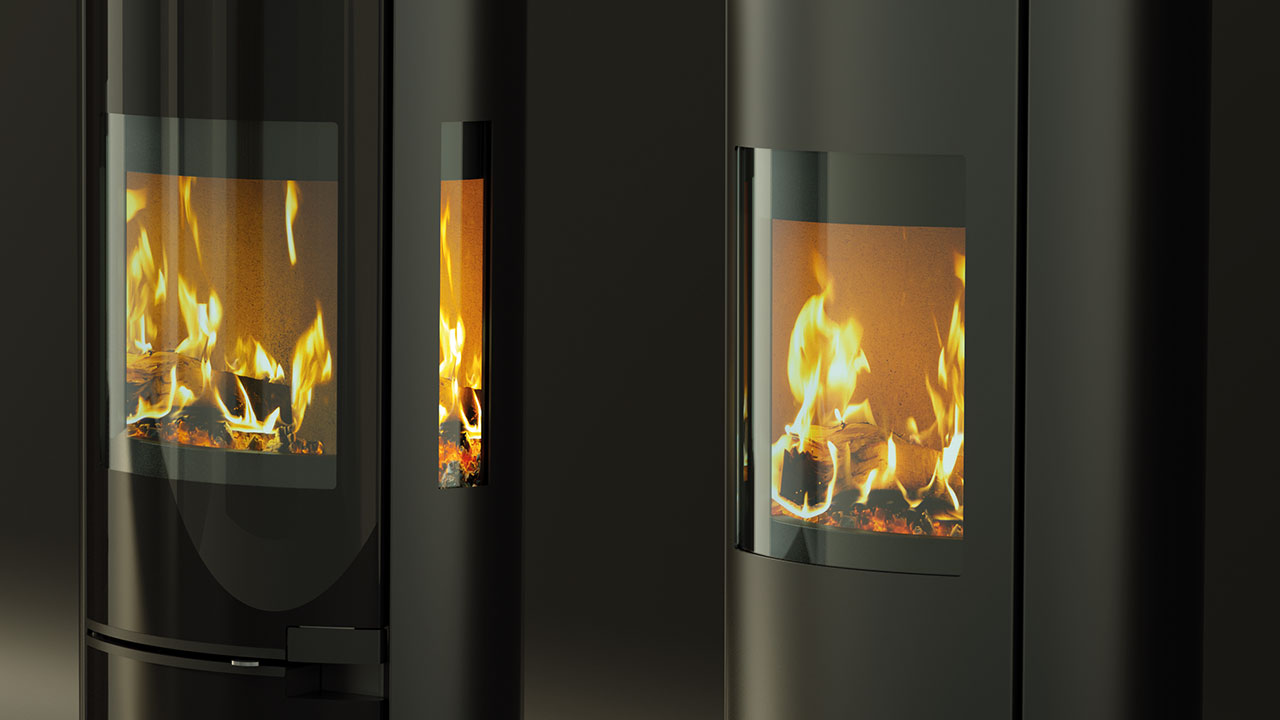Distance to Combustibles – FAQs
One of the Frequently Asked Questions asked about chimney and flue installation is the “Distance to Combustibles”. So what does this mean?
This simply means the gap needed between the chimney flue pipe or chimney flue block to a timber frame or similar material which would burn when heated (i.e. combustible). It’s a critical safety aspect which can’t be ignored and some of the confusion is that some chimney systems have differing distances, so we’ll try and explain here.
Please note that this article is about the distance to combustibles for chimneys and flues, which is different for the actual stove or other appliance. All stoves tend to have different distances to combustibles, so a careful look at the appliance instruction guide is obviously recommended.
Distance to combustibles with the new G50 (50mm) ventilated firestop plates on ICID twin wall systems
Firestop plates are critical in preventing fire from being transferred from one room to another in the house and to allow time for safe evacuation of residents in case of fire.
In order to prevent heat build up within a combustible floor or ceiling or within the shaft, the ventilation slots are specifically designed to prevent heat from building up, allowing cooling air to pass through the slots thereby reducing temperatures within the floor/ceiling cavity and shaft whilst preventing flames from passing between compartments.
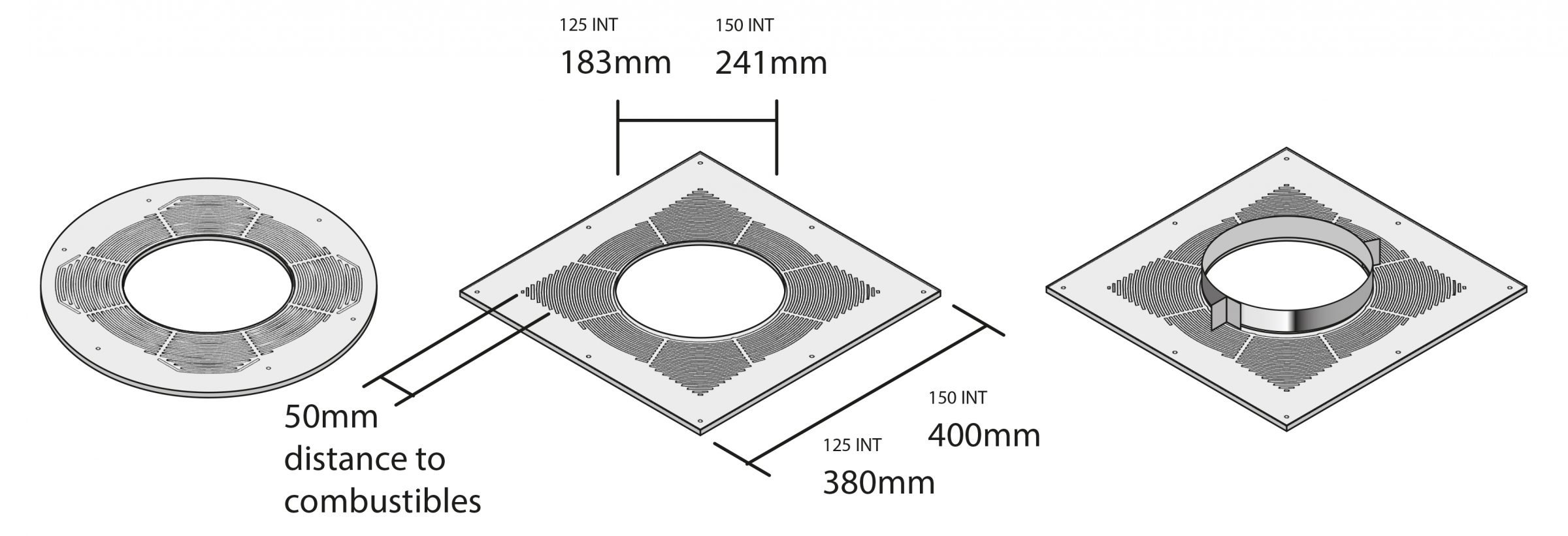 The updated G50 firestop ventilation plates from Schiedel mean that the outside edge of the ventilation slot pattern gives a distance to combustibles of 50mm.
The updated G50 firestop ventilation plates from Schiedel mean that the outside edge of the ventilation slot pattern gives a distance to combustibles of 50mm.
This measures the required minimum distance to combustibles on solid fuel applications, which means the fixing holes outside of these can be used to attach the firestops to joists and frames. There is no requirement to line out the floor cavity with fire proof board when using the Schiedel ICID system.
It’s critical that none of the ventilation slots are blocked by any plasterboard, joists or noggins as all the slots are used in ensuring sufficient movement of free air.
The ventilated firestop plates are used in combination with standard ICID Plus pipes where the chimney passes through a combustible floor or ceiling and through a shaft.
ICID Plus twin wall chimney system.
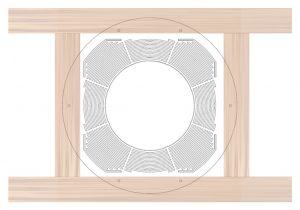 G50 is a key designation of our ICID twin wall system, which is ideal for traditional stoves as well as more innovative appliances, such as pellet stoves, biomass stoves and boilers, mini/micro CHP and even condensing boilers.
G50 is a key designation of our ICID twin wall system, which is ideal for traditional stoves as well as more innovative appliances, such as pellet stoves, biomass stoves and boilers, mini/micro CHP and even condensing boilers.
ICID Plus has been tested and approved to meet the latest BS EN1856-1 requirements when passing through either combustible or non combustible floors with a distance to combustible material of 50mm within both the floor cavity and within a shaft. The firestop plates also have a 30 minute fire rating to BS476 Part 20 in line with Approved Document B which covers fire safety.
All the tests have been carried out using the latest design of ventilated firestop plate, in both round and square versions and the new ventilated support plate. The updated G50 Ventilated Square and Round Firestop plates have been engineered to provide an increased air flow around the flue, which keeps the area around the chimney inside the enclosure cooler during operation.
There is no requirement to line the timbers to achieve the 50mm distance to combustibles.
ICID’s outer case is load bearing whilst the inner liner is free to expand independently, which allows thermal expansion within each joint. It’s also designed to be particularly resistant to corrosion with a laser welded 316L stainless steel inner liner and case.
Lifetime guarantee.
At Schiedel, we pride ourselves on developing the very best in innovative, long-lasting flueing and chimney solutions.
The ICID system has been manufactured at our Plant in Washington, Tyne and Wear for more than 50 years, giving us the experience to be able to commit to our Lifetime Guarantee and providing peace of mind to our distributors, installers and end users. Our Guarantee is linked to the property in which the product is installed, not to the householder, therefore the guarantee is a transferable asset when the property is sold, providing that the products have been specified, installed and maintained correctly.
Our ICID product range is available in a variety of sizes and finishes, and with our attention to detail on aesthetic design of components, it offers a very attractive option for a wide variety of installations.
The availability of high-quality accessories which are fully compatible with the system and carry the same guarantee, means the installer and the end user can be confident in the compatibility and quality of the complete installation.
Because the insulation isn’t natural, like pumice. This means when burning solid fuel such as wood in a steel chimney, you need 60mm between the steel pipe and the building frame or floor, etc. There’s no need to line the floor area with plasterboard, but a ventilated fire stop plate and support plate must be used.
For Gas and Oil, a distance of 50mm can be maintained and a ventilated fire stop plate and support plate must be used. This is because the temperature is less than it would be for solid fuel.
If it’s non-combustible wall, i.e. won’t burn when heated up, such as a plain, un-rendered brick wall, then 50mm may be used. Remember, brickwork does heat up, but might not spurt into flames, however, a wooden beam next to it would be heated by the bricks and probably start burning. So this must be taken into account.
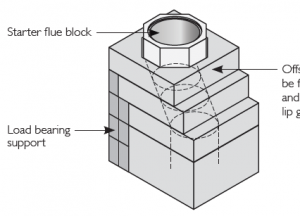 [wpanchor id=”isokerndm”]Schiedel’s Isokern DM Chimney System
[wpanchor id=”isokerndm”]Schiedel’s Isokern DM Chimney System
Requires 0 or 38mm distance to combustibles. 0mm distance is only on straight rendered chimneys, when using top ring terminal. A top ring vents the gap between inner flue and outer casing block which reduces the surface temperature.
Note: When using offset systems and non-ventilated systems. A 38mm distance is needed, because it seals the air gap off, as it’s not ventilated.
[wpanchor id=”thatchedroofs”]Thatched Roofs
For a thatched roof a 38mm distance is required from the outer surface of the DM chimney system to the thatch.
[wpanchor id=”pumiceliners”]Schiedel Isokern Pumice Liners
For Liners, 200mm from the inner surface of flue liner to combustibles. Isokern liners can be used inside brick or block chimneys but they require 15mm of light expanded clay aggregate between the liners and surrounding masonry.
[wpanchor id=”condensingandnoncondensing”]Condensing and Non-condensing boilers distances to combustibles
On condensing appliances where the temp will not exceed 200C, the tested approved distance to combustibles is 0 mm, because the hot gases don’t pass to the flue directly and go to a second heat exchanger chamber
For reference, a Non-condensing boiler has a just one heat exchanger chamber, where the hot gases from the burner, pass through to heat the water, which is passing through within the walls of the exchanger chamber. The hot gases then reach the exit flue.
While a Condensing boiler operates similarly, but before the hot gases go through the flue, they pass through a second heat exchanger. In simple terms, this lengthens the heat transfer time, and also increases the surface area for heat transfer of gases or water. As a result this can give an increase in efficiency
[wpanchor id=”flexliners”]Flexible liners
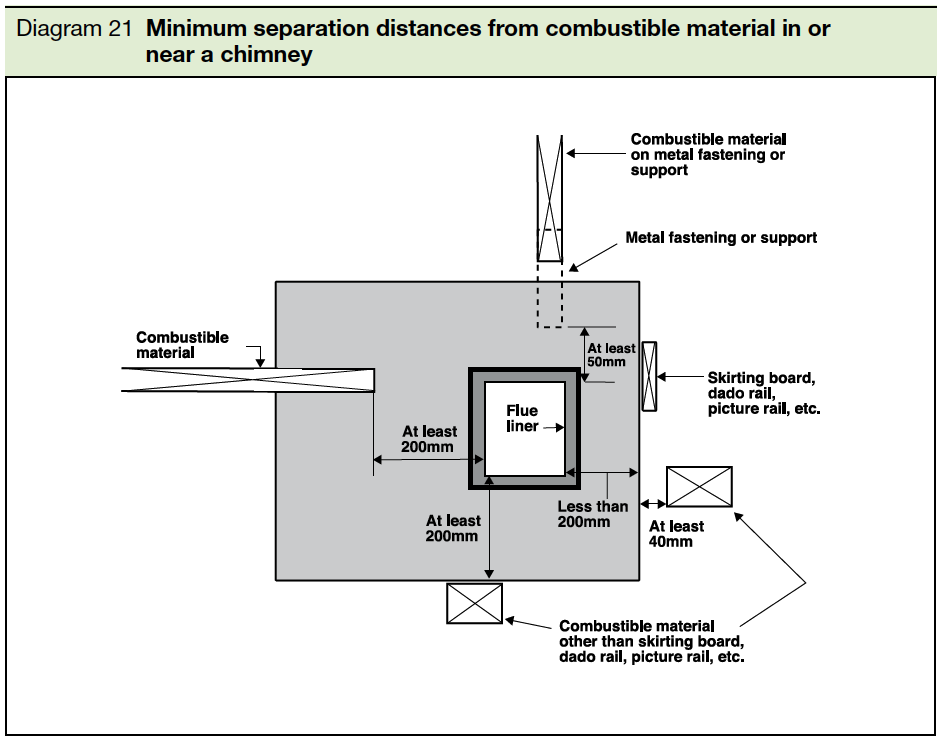 Flex liners, in most cases, tend to drop down an existing non-combustible chimney, which tend to be brick built. As explained before, bricks don’t burn but do heat up. For a flexible liner this reduces the need for any distance to combustibles, however, consideration has to be taken as to the layout and position of the chimney.
Flex liners, in most cases, tend to drop down an existing non-combustible chimney, which tend to be brick built. As explained before, bricks don’t burn but do heat up. For a flexible liner this reduces the need for any distance to combustibles, however, consideration has to be taken as to the layout and position of the chimney.
Doc J of Building Regulations shows a diagram in regards to minimum separation distances from combustible material in or near a chimney
Where the chimney is highly exposed or in a large void, then insulation should be considered. If insulation is required, granules such as Vermiculite, should be poured in around the liner from the top of the stack after fitting a suitable closure plate at the bottom of the system. Alternatively a solid tube of high quality insulation can be used.
Under all circumstances, the chimney stack must be fully weather proofed prior to the installation of the liner and any insulation material. Failure to do so will render the warranty null and void.
Flexible liners expand and contract in the heat, so the less amount of movement means a longer lasting flexible liner.
[wpanchor id=”ceramicliners”]Ceramic liners
High temp cement is added to the joints in ceramic liners but the gap between the liner and the surrounding wall cavity is filled with LECA insulation. At least 15mm is needed. Ceramic is also a good insulator.
[wpanchor id=”swift”]Schiedel’s Swift
Schiedel’s Swift system is similar to Isokern in the use of blocks. The three layer system adds much more insulation, to make it one of the safest systems around. The first layer is the ceramic liner, which is surrounded by the second layer: insulation board. Finally, being added into the chimney block which adds more insulation. More insulation means more safety and also less heat loss.
[wpanchor id=”ignisprotect”]Ignis Protect
Ignis Protect was specifically designed by Schiedel for external walls which are made of combustible materials.
The single block allows a pipe to go through an insulation block with a wall sleeve to the exterior of the building. Ignis Protect can also be painted/rendered to match the exterior and interior of the wall
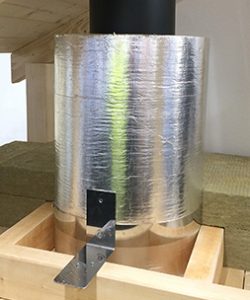
Protect Box, giving Zero distance to combustibles.
[wpanchor id=”protectbox”]Protect Box
Protect box was specifically designed by Schiedel for combustible roofs. This gives zero distance as the steel pipe is passed through an insulation cylinder made of rock wool with an aluminium surface.



